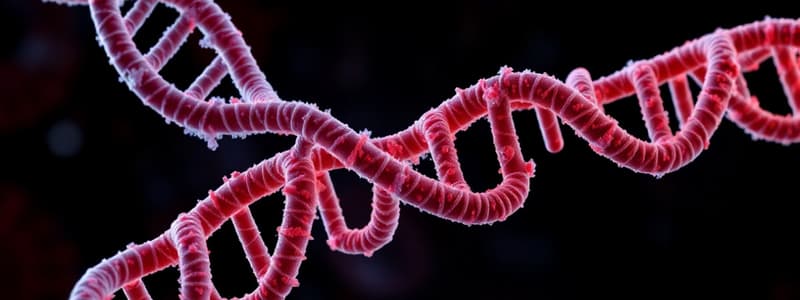Podcast
Questions and Answers
What is the primary function of gene expression?
What is the primary function of gene expression?
- To maintain the structural integrity of DNA.
- To regulate the rate of DNA replication.
- To prevent mutations from occurring in the genome.
- To transcribe RNA and eventually produce functional proteins. (correct)
How do regulatory proteins influence gene expression?
How do regulatory proteins influence gene expression?
- By modifying the structure of ribosomes to prevent translation.
- By catalyzing the degradation of mRNA molecules.
- By binding to DNA and either blocking or stimulating transcription. (correct)
- By directly altering the DNA sequence of a gene.
What distinguishes constitutive gene expression from induced or repressed expression?
What distinguishes constitutive gene expression from induced or repressed expression?
- Constitutive expression only produces non-coding RNA, whereas others produce proteins.
- Constitutive expression is continuous, while induced and repressed expression fluctuate in response to external signals. (correct)
- Constitutive expression only occurs during embryonic development.
- Constitutive expression requires external signals for activation, unlike induced expression.
Why is gene expression in multicellular organisms more complex than in prokaryotes?
Why is gene expression in multicellular organisms more complex than in prokaryotes?
What is the main function of untranslated regions (UTRs) found in exons?
What is the main function of untranslated regions (UTRs) found in exons?
Which of the following is NOT a key event in the process of gene expression?
Which of the following is NOT a key event in the process of gene expression?
What is the primary benefit of bacteria quickly responding to environmental changes?
What is the primary benefit of bacteria quickly responding to environmental changes?
How does feedback inhibition regulate metabolic pathways in bacteria?
How does feedback inhibition regulate metabolic pathways in bacteria?
What is a key difference between feedback inhibition and gene regulation in bacterial metabolism?
What is a key difference between feedback inhibition and gene regulation in bacterial metabolism?
Why is gene regulation considered a more efficient method of regulating metabolism than feedback inhibition?
Why is gene regulation considered a more efficient method of regulating metabolism than feedback inhibition?
What is the role of the operator in gene regulation within an operon?
What is the role of the operator in gene regulation within an operon?
In the operon model, what happens when a gene is turned 'ON'?
In the operon model, what happens when a gene is turned 'ON'?
How does a repressor protein turn a gene 'OFF' in the operon model?
How does a repressor protein turn a gene 'OFF' in the operon model?
What is the primary function of the trp operon?
What is the primary function of the trp operon?
Which statement best describes repressible operons?
Which statement best describes repressible operons?
How does tryptophan affect the trp repressor protein when tryptophan levels are high?
How does tryptophan affect the trp repressor protein when tryptophan levels are high?
What is the primary function of an inducible operon?
What is the primary function of an inducible operon?
In the lac operon, what role does lactose play when it is present in the cell?
In the lac operon, what role does lactose play when it is present in the cell?
What is the state of the lac operon when glucose is abundant, and lactose is absent?
What is the state of the lac operon when glucose is abundant, and lactose is absent?
Which of the following best describes the function of an operon?
Which of the following best describes the function of an operon?
Are the key components of gene expression RNA polymerase, protein processing and transcription?
Are the key components of gene expression RNA polymerase, protein processing and transcription?
What is the difference between exons and coding sequences?
What is the difference between exons and coding sequences?
What is the reason that eukaryotes have more complex gene regulation?
What is the reason that eukaryotes have more complex gene regulation?
What do regulatory genes produce?
What do regulatory genes produce?
What are some genes that are continuously expressed called?
What are some genes that are continuously expressed called?
What is it called when a gene demonstrate an increased level of expression once activated?
What is it called when a gene demonstrate an increased level of expression once activated?
Which of these statements is true about controlling Gene Expression?
Which of these statements is true about controlling Gene Expression?
If a bacteria has enough of a product, why does it need to stop production?
If a bacteria has enough of a product, why does it need to stop production?
What is the function of an allosteric inhibitor in feedback inhibition?
What is the function of an allosteric inhibitor in feedback inhibition?
Why are genes grouped together in bacteria?
Why are genes grouped together in bacteria?
What molecules are involved in the Tryptophan Operon?
What molecules are involved in the Tryptophan Operon?
What happens in lac operon is lactose is present?
What happens in lac operon is lactose is present?
Which operon functions in anabolic pathways and involves synthesizing end products?
Which operon functions in anabolic pathways and involves synthesizing end products?
Flashcards
Gene Expression
Gene Expression
The process by which a gene is turned on to produce RNA and proteins.
Housekeeping Genes
Housekeeping Genes
Genes that are continuously expressed because they are essential for life.
Induction and Repression
Induction and Repression
When some genes' expression levels change based on external signals.
Exons
Exons
Signup and view all the flashcards
Compartmentalization
Compartmentalization
Signup and view all the flashcards
Key Events in Gene Expression
Key Events in Gene Expression
Signup and view all the flashcards
Gene Regulation
Gene Regulation
Signup and view all the flashcards
Feedback Inhibition
Feedback Inhibition
Signup and view all the flashcards
Gene Regulation
Gene Regulation
Signup and view all the flashcards
Operon
Operon
Signup and view all the flashcards
Promoter
Promoter
Signup and view all the flashcards
Operator
Operator
Signup and view all the flashcards
Gene Turned ON
Gene Turned ON
Signup and view all the flashcards
Gene Turned OFF
Gene Turned OFF
Signup and view all the flashcards
Tryp Operon Model
Tryp Operon Model
Signup and view all the flashcards
Repressible Operons
Repressible Operons
Signup and view all the flashcards
Inducible Operons
Inducible Operons
Signup and view all the flashcards
Repressible Operon (Tryptophan)
Repressible Operon (Tryptophan)
Signup and view all the flashcards
Repressible Operon Off
Repressible Operon Off
Signup and view all the flashcards
Tryptophan
Tryptophan
Signup and view all the flashcards
Inducible Operon
Inducible Operon
Signup and view all the flashcards
Lactose
Lactose
Signup and view all the flashcards
Repressible Operons
Repressible Operons
Signup and view all the flashcards
Inducible Operons
Inducible Operons
Signup and view all the flashcards
Study Notes
Gene Expression
- Process where a gene activates in a cell to transcribe RNA and produce proteins
- Instructions in DNA convert into a functional product, usually a protein
- Information from a gene synthesizes a functional gene product like proteins, tRNA, or snRNA
Control of Gene Expression
- Gene expression is often controlled by transcription initiation
- Regulatory gene products are needed to initiate (turn on) or stop (turn off) expression
- Regulatory genes make regulatory proteins that bind to DNA, either blocking or stimulating transcription based on interaction with RNA polymerase
Types of Gene Expression
- Some genes are essential and continuously expressed in cells; they are known as housekeeping genes
- Gene expression levels for some genes change in response to external signals
Gene Expression in Multicellular Organisms
- Every cell contains all genes, but only certain proteins are needed
- Gene expression at the wrong time, in the wrong cell type, or in abnormal amounts can cause issues
- Induced expression occurs when some genes show higher expression once activated
- Repressed expression occurs when some genes are repressed and their expression levels are lower
Exons and Coding Sequences
- Exons are spliced after introns are removed from pre-mRNA
- Coding sequences are in exons, however not all exons contain coding sequences
- Untranslated regions (UTRs) are sequences in exons not translated into amino acids
- UTRs are found upstream and downstream of the protein-coding sequence
Gene Expression in Prokaryotes and Eukaryotes
- Eukaryotes have more complex gene expression controls than prokaryotes
- Eukaryotic complexity arises due to compartmentalization of cells
- Eukaryotes have different cell organelles performing specific functions, preventing functional interference
- Eukaryotic cells have more extensive transcript processing, regulation from a distance, cell and tissue specific gene expression, larger genome size, and genes scattered in the genome
Key Events in Gene Expression
- 4 major events include: transcription, RNA processing, translation, and protein processing
Gene Regulation
- Bacteria respond quickly to environmental changes
- Bacteria stop production if they have enough of a product
- Bacteria will utilize new food and energy sources quickly
Bacterial Metabolism
- Bacteria halt enzyme synthesis when enough product is available to conserve energy
- Bacteria initiate enzyme production for digestion when a new food source is found
Regulating Metabolism
- Feedback inhibition is where the product acts as an allosteric inhibitor of the first enzyme in a pathway
- Gene regulation blocks gene transcription for all enzymes in a pathway instead of blocking enzyme function
- Blocking transcription saves energy by avoiding unnecessary protein synthesis
Gene Regulation in Bacteria
- Cells regulate gene transcription to vary the amounts of specific enzymes produced
- Genes can be turned on or off
- Example is genes are turned off if the bacterium has enough tryptophan
- Genes are turned on to digest lactose if a bacterium encounters lactose
Jacob & Monod
- Francois Jacob and Jacques Monod: first to describe operon systems and coined the term "operon" in 1961
Bacterial Gene Grouping
- Genes with related functions are grouped together in the operon
- All enzymes in a metabolic pathway is an example of operons
- A single promoter controls transcription of all genes in an operon
- The genes are transcribed as one unit to produces a single mRNA
- The operator signifies the DNA binding site of the repressor protein
Operon Model (Gene Turned On)
- RNA polymerase binds to the promoter and the gene is transcribed
Operon Model (Gene Turned Off)
- The repressor binds to the operator site, which blocks RNA Polymerase
Repressor Protein
- Repressor protein binds to DNA at the operator site to block RNA polymerase and blocks transcription
The Tryp Operon Model
- Functions as a model for gene regulation due to the operator, promoter, and genes it controls
Repressible Operons
- Genes that are naturally on, and are turned off
- The trp operon synthesizes enzymes used in tryptophan synthesis
Inducible Operons
- Genes that are naturally off, and are turned on
- The lac operon produces enzymes used in lactose digestion
Tryptophan (Repressible) Operon
- Needed for use when the gene is naturally on
- Repressor protein initially exists as an inactive form
- Cell produces enzymes for tryptophan synthesis
Trytophan Synthesis
- When excess tryptophan is present, it binds to the trp repressor protein, triggering the repressor to bind to DNA and block transcription; it will then create a synthesis pathway model
Repressible Operon Example
- There is no need to make tryptophan-building enzymes when tryptophan is present
- Tryptophan is an allosteric regulator of repressor protein
Lactose Operon
- Active transport of lactose requires lactose-digesting enzymes
- The lactose operon is a digestive pathway model
Lactose Digestion
- Glucose is the preferred food source
- Lactose digesting enzymes are not a necessity
- Inducible operon that is naturally turned off
Inducible Operon
- When lactose is present, it binds to the lac repressor protein, triggering the repressor to release DNA, thereby inducing transcription
Repressible Operon Summary
- Functions in anabolic pathways in the body
- Synthesizes end products
- If the end product is present in excess it allocates resources to other uses
Inducible Operon Summary
- Functions in catabolic pathways in the body
- Digests nutrients to simpler molecules
- Enzymes produce only when the nutrient is available
- The cell avoids making proteins that are unneeded and allocates cell resources to other functions
Studying That Suits You
Use AI to generate personalized quizzes and flashcards to suit your learning preferences.




